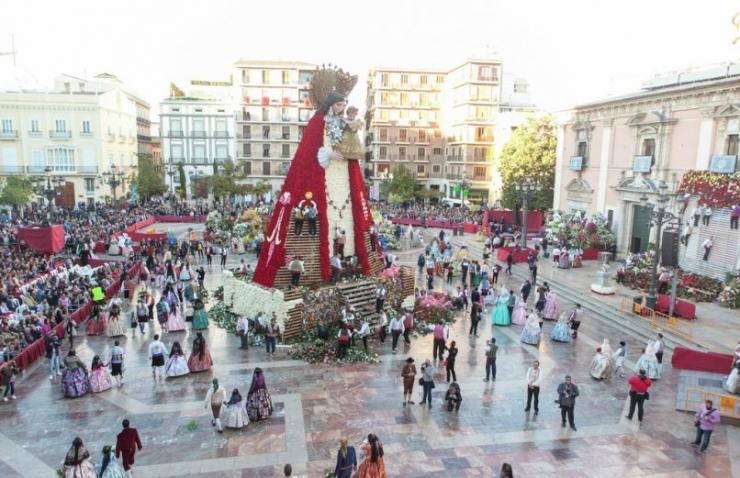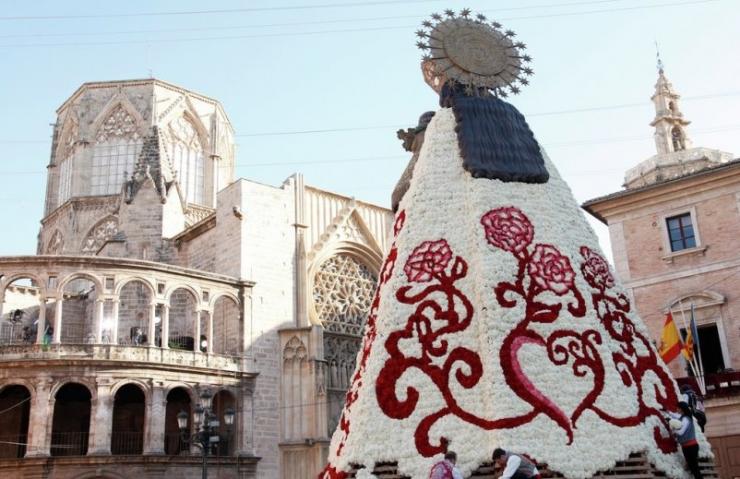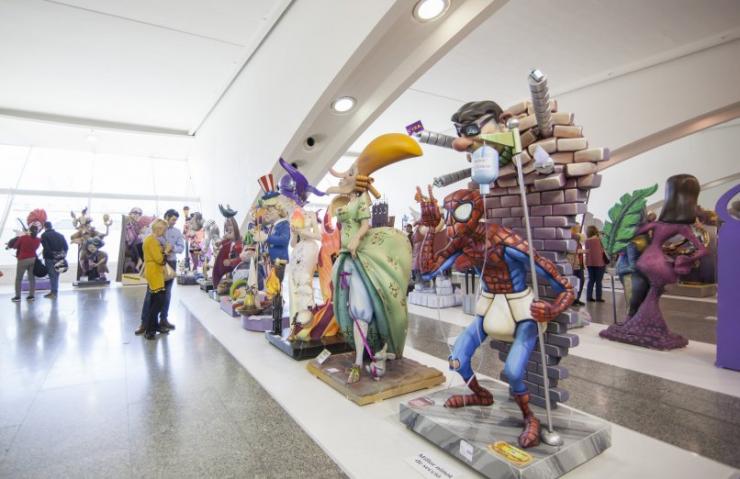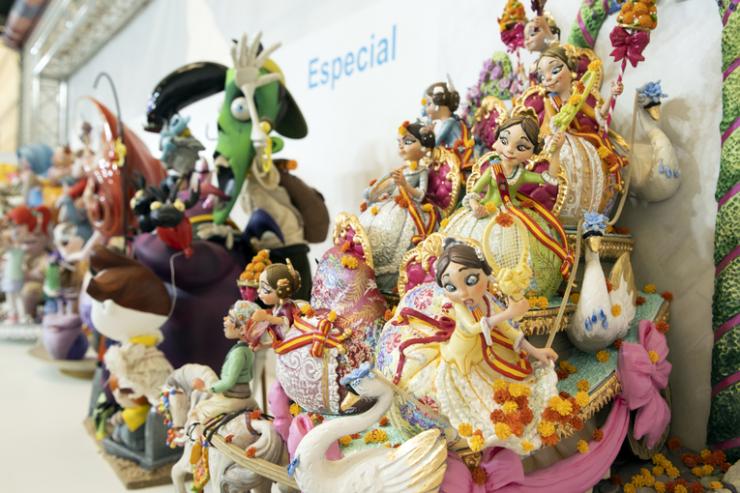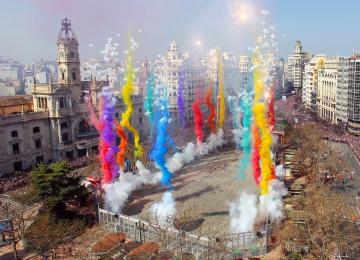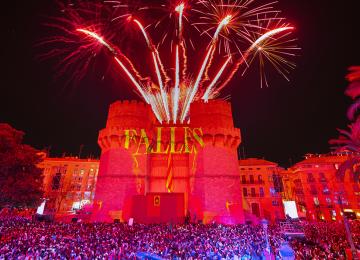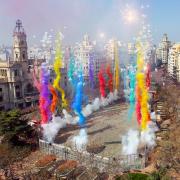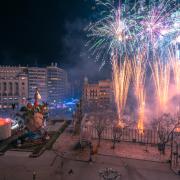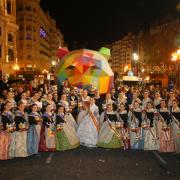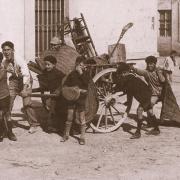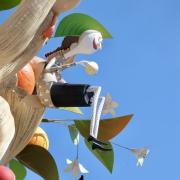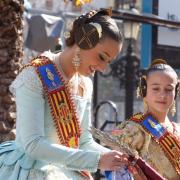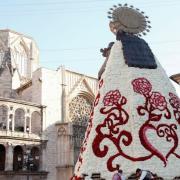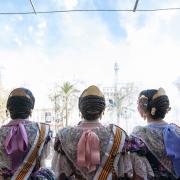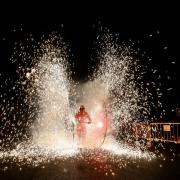Everything you need to know about the Fallas in Valencia.
What are the Fallas?
Las Fallas are Valencia's most universal festival, declared Intangible Cultural Heritage of Humanity by UNESCO. Its name refers to the spectacular sculptural monuments made of wood and papier mâché that are placed in the city’s streets and squares to be admired before they succumb to the flames. In addition to the large fallas, there are also children's fallas, much smaller in size, designed by and for the little ones.
When are the Fallas held in Valencia?
The Fallas are celebrated in March. The origin of the festival goes back to the tradition of improvising bonfires with old furniture to celebrate the arrival of spring, and it also coincides with the celebration of St. Joseph's Day, the patron saint of carpenters. The festive events begin on the last Sunday in February with the Crida, in which the falleras mayores spur people on to have fun at the Fallas. Then, from March 1st onwards, the Mascletà is fired daily in the City Hall square. The main dates, though, are from March 15th to 19th, when the plantà begins and the cremà (burning) of the monuments happens.
What can you see at the Fallas in Valencia?
The main attraction, without a doubt, are the hundreds of fallas, or fallero monuments, which are "planted" in streets and squares all over the city. Each falla usually follows a theme and consists of numerous individual sculptures or sculptural groups, called ninots, which tell their own story. They often depict famous people or critique current affairs, always with a good dose of humour, satire, and creativity. Just as important as appreciating their art and meaning is the thrill of watching them burn on the night of 19 March.
But there is much more to see in the Fallas. Don't miss the firework displays, from the mascletaes that happen every day to the dazzling Nit del Foc (Night of Fire) on the night of March 18th, or the colourful and devotional Flower Offering to the Virgen de los Desamparados (Our Lady of the Forsaken), which takes place on March 17th and 18th. Here you will see thousands of falleros and falleras dressed in their traditional costumes, examples of the best Valencian craftsmanship. There is no lack of music either, with concerts and parades taking place through the city centre.
How many Fallas are there in Valencia?
During the Fallas festivities, around 800 Fallas monuments are set up in Valencia’s streets and squares. Half of them are to do with the children's commissions, which are smaller in size and have themes aimed at the youngest children, and the other half to the major commissions.
When are the Fallas burnt in Valencia?
The cremà is the final act of the Fallas, when the hundreds of fallas monuments succumb to the flames in spectacular bonfires. It takes place on the night of March 19th, and is staggered between 20:00 and 23:00, which means it is possible to see more than one falla burning.
The first to burn are the children's fallas, at 20:00, with the exception of the first prize winner, which burns at 20:30, and the children's falla in the Plaza del Ayuntamiento (City Hall Square), which burns at 21:00. At 22:00 is the cremá of all the fallas in Valencia, except for the first prize winner, which is lit at 22:30. The last falla to burn is the one located in the Plaza del Ayuntamiento, at 23:00, in an event that attracts large crowds and brings the festival to a close.
Where are the fallas kept?
The fallas, or rather the different elements and ninots that make them up, are built in large warehouses, most of them in the Ciudad del Artista Fallero. Here they remain until the moment of the plantà, when the fallero artists install them in streets and squares around Valencia and put the finishing touches to them. The children's fallas are ready for public visits on March 15th and the big fallas can be seen on the 16th.
Not everything burns in the Fallas. Every year a ninot from one of the fallas and a children's ninot are pardoned by popular vote. The ninots that have been pardoned over the years - since 1934! - are kept and can be visited in the Fallas Museum. Here you will also find posters and photographs of the Fallas, as well as a wealth of information to help you better understand the symbolism of the festival.
What is the best Falla in Valencia / Where are the best Fallas in Valencia?
All the fallas are works of art, and everyone will have their favourite, according to their personal tastes. However, there is an official competition and, each year, a jury judges the fallas that enter the competition according to criteria such as innovation or technical and artistic quality. On March 16th, different prizes are awarded in different categories, depending on the size or investment in the falla. The top prize is the first prize in the so-called Special Section, for both large and children's fallas. These fallas are considered the best and are usually the ones that are most visited.
What is the mascletà in the Valencia Fallas?
The mascletà is a firework display like no other, which has to be experienced to be understood. It is usually held during the day, at 14:00, although there are also night-time mascletaes. They are a few intense minutes of explosions whose rhythm and volume increase progressively, filling the space with the smell of gunpowder and making both the ground and the hearts of those who are watching it tremble. It is an intrinsic element of any festival in Valencia, and is an essential part of the Fallas, with daily mascletaes from the March 1st to the 19th in the City Hall square.
When is the mascletà de Fallas?
The mascletà is held daily at 14:00 from March the 1st to the 19th in the Valencia City Hall Square. The falleras mayores are responsible for signalling the start of the show, from the City Hall balcony. It is an event that attracts large crowds, who begin to gather in the square up to an hour before the start, especially for the mascletaes on the big days of the Fallas, from the March the 15th to the 19th. This is the most spectacular and popular, but many fallas also fire their own mascletà. They usually do so after the one at the City Hall, at around 14:30 and 15:00, in different neighbourhoods around the city.
How many mascletaes are there during the Fallas?
There are 19 mascletaes during the Fallas. They are held daily at 14:00h from March 1st to 19th in the Valencia City Hall Square. In addition, some fallas usually fire their own mascletà during the Fallas week. It is common to hear them at midday in different neighbourhoods around the city.
What is the Fallas flower offering?
The offering of flowers to the Virgen de los Desamparados (Our Lady of the Forsaken) is one of the most colourful and stirring events of the Fallas. For two days, on March the 17th and 18th, thousands of falleros and falleras from different city neighbourhoods, as well as delegations from other provinces and regions, bring flowers to a gigantic image of the patron saint of Valencia that is placed in the Plaza de la Virgen. The flowers gradually form a colourful mantle for the Virgin, the design of which varies each year. The parade through the streets of the city is impressive in itself, due to the colourful traditional costumes of the participants and the music that accompanies them.
When is the Fallas flower offering?
The offering of flowers to the Virgen de los Desamparados (Our Lady of the Forsaken) takes place on March 17th and 18th. Thousands of falleros and falleras parade through the streets of the city from 3:30 pm onwards to bring flowers to a gigantic image of the patron saint of Valencia that is installed in the Plaza de la Virgen. The fallera mayor is the last to make her offering, after midnight on 18 March.
When are the flowers from the offering taken away?
The offering of flowers ends after midnight on March 18th, when the fallera mayor delivers her flowers to complete the mantle of the Virgen de los Desamparados (Our Lady of the Forsaken). The gigantic image of the patron saint of Valencia, with her new mantle of flowers, remains for a few days in the Plaza de la Virgen, for locals and visitors alike to enjoy.
Where are the ninots of the Fallas?
The ninots are the individual sculptures or groups of sculptures that make up the fallas, which can be seen in streets and squares around Valencia from 16th to 19th March. From January 31 to March 15th, a selected ninot from each falla is exhibited at the Ninot Exhibition, which this year is being held at the Sciences Museum, to be put to a popular vote. The ninot chosen by visitors to the exhibition will be saved from the fire, and will be kept in the Fallas Museum, where all the pardoned ninots from previous years' fallas can be seen.
Where can you see Ninots in Valencia?
From January 31 to March 15th, the ninots that are candidates to be saved from the fire can be seen at the Ninot Exhibition, which this year is being held at the former Alinghi base at the Sciences Museum. It is a foretaste of what will be seen in the fallas that will be ‘planted’ in the streets and squares of Valencia and can be visited from 16 March until their cremà on the night of March 19th. One of the ninots in the exhibition will be pardoned by popular vote. In the Fallas Museum you can see the ninots pardoned in all the editions of the Fallas since 1934.
Where is the Ninot Exhibition?
This year, for the first time, the Ninot Exhibition will be at the former Alinghi base in the Marina de Valencia, from January 31 to March 15th, 2025.
What is the Ninot Exhibition?
The Ninot Exhibition is a preview of the Fallas, where the ninots are exhibited as candidates to be saved from the fire. Each Fallas commission selects one ninot from their falla and one from the children's falla for the Exhibition, where visitors vote for their favourite to be pardoned. On March 15th, the winner is announced, and the two pardoned ninots are moved to the Fallas Museum, while the rest return to their corresponding fallas around the city, destined to burn on the night of March 19th.
YOU MAY ALSO LIKE
Events Calendar
fallas
Fallas Festival Events Calendar 2026
fallas
Pyrotechnical calendar for the 2026 Fallas, mascletàs and fireworks
fallas
Night-time pyrotechnic shows in Plaza del Ayuntamiento
fallas
Ninot Parade of the Fallas 2026
music
Cant de l'Estoreta Velleta 2026 Contest in Plaza del Carmen
exhibitions
Fallas Festival Ninot Exhibition
fallas
The Night of the Plantà of the Fallas
fallas
Presentation of the Fallas awards
fallas
Firework Displays, Nightly Mascletàs, and Nit del Foc
fallas
Flower Offering of the Fallas festivities
fallas
Mascletà of the Fallas festival in the Plaza del Ayuntamiento
fallas
The Crema, the day when the Fallas of Valencia are burned.
fallas
A unique show is back, the Parade of Fire
Gastronomy












